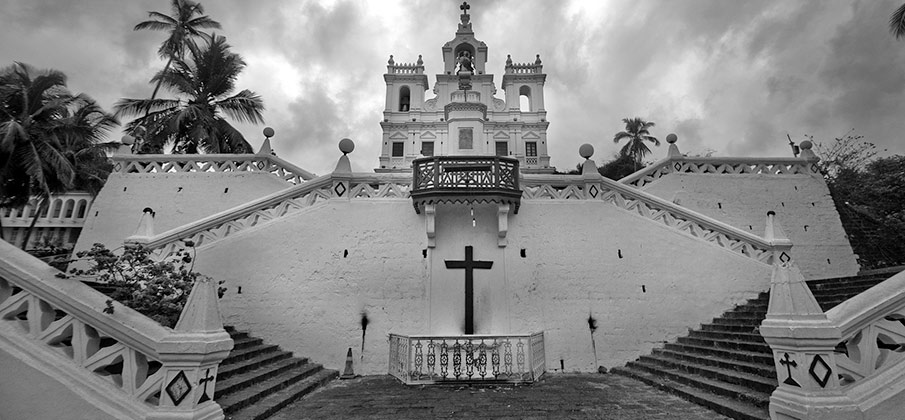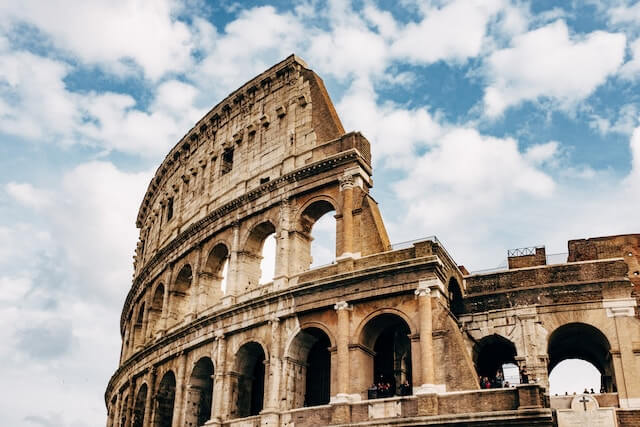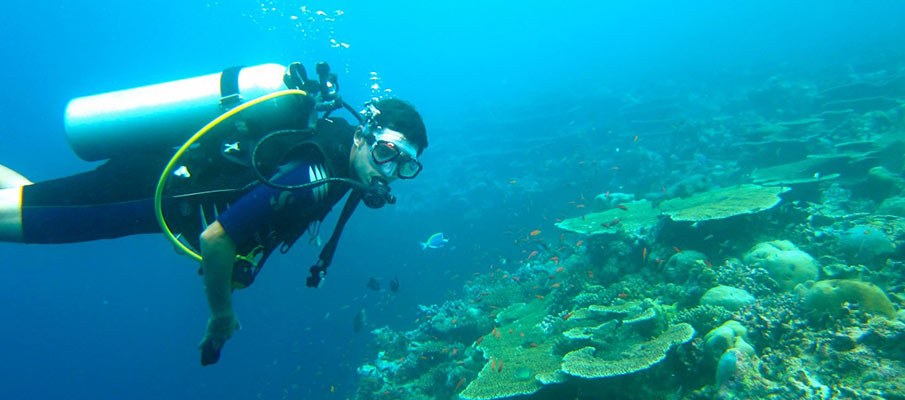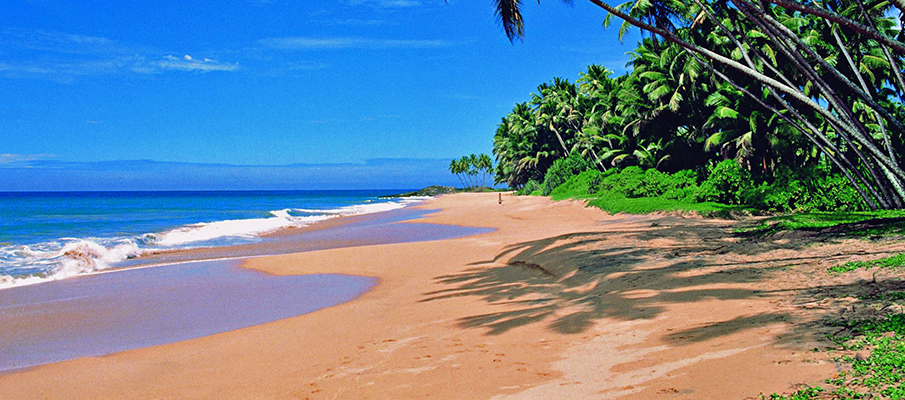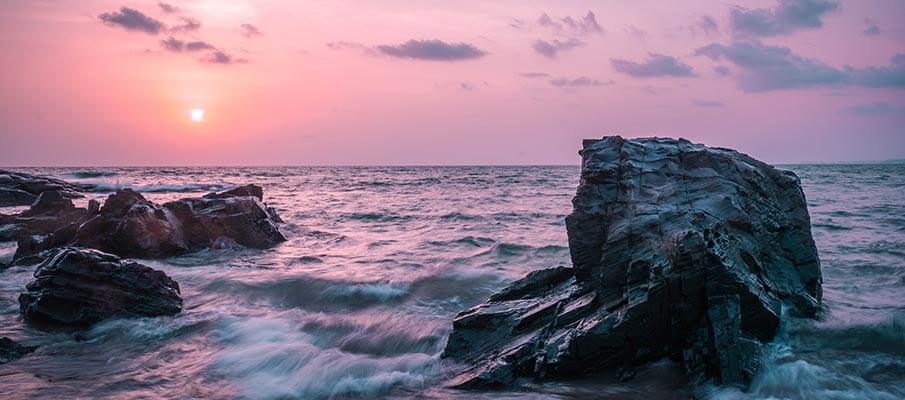Goa’s warm beaches, cool waters, ancient churches, and majestic forts attract hundreds and thousands of visitors from all over the world, every year. While many tourists flock to the beach to bask under the hot sun or swim in the sparkling, blue sea water, there are other tourists who wish to indulge in the place’s rich, cultural, religious and historical past.
This list compiles some of the top Places to See in Old Goa and its most iconic landmarks. From grand basilicas, tombs and churches, to tall forts and modern museums, this list gives tourists the best suggestions to make the most out of their visit to Old Goa.
Contents [hide]
- Discovering Old Goa
- 1) Basilica of Bom Jesus: A UNESCO World Heritage Site
- 2) Tomb of St. Francis Xavier
- 3) Divar Island
- 4) Reis Magos Fort: Panoramic Views of the Mandovi River
- 5) Se Cathedral: A Magnificent Example of Portuguese Architecture
- 6) Fontainhas: The Latin Quarter of Panaji
- 7) Wax World Museum
- 8) Ruins of St. Augustine Church: Echoes of a Bygone Era
- 9) Church of St. Cajetan: Gothic Splendor in Old Goa
- 10) Archaeological Museum and Portrait Gallery: Treasures of Old Goa
- Bonus Places:
- 11) Mangueshi Temple: Spiritual Oasis amidst Christian Heritage
- 12) Church of St. Francis of Assisi: A Testament to Franciscan Heritage
- 13) Viceroy’s Arch: Gateway to Old Goa
- 14) Chapel of St. Catherine
- 15) Museum of Christian Art
- FAQs About Old Goa
- 15 Best Weekend Getaways from Delhi
- New Year in Goa on a Budget
- [Infographic] India's Animal Species That Your Kids Might Not Get To See
- Halebidu and Belur Travel Guide
- 10 Incredible Caves near Mumbai You Must Visit
- Top 10 Things To Do in Lakshadweep
- 10 Offbeat Places in Uttarakhand You Must Visit
- Scuba Diving in Andamans - Home of Best Dive Sites in India
Discovering Old Goa
Exploring the Rich Heritage
Old Goa serves as a captivating time capsule, preserving the architectural marvels of bygone eras. Its cobblestone streets and colonial buildings narrate tales of Portuguese colonization and Indo-European fusion. Each corner unfolds a new chapter, inviting visitors to delve into the annals of history.
Embracing the Cultural Diversity
Beyond its architectural splendors, Old Goa thrives with a tapestry of cultures. From the melodious chants at ancient churches to the aromatic spices in local markets, the town celebrates diversity in every aspect. Explorers can immerse themselves in the vibrant festivals, where traditions intertwine with modernity in a harmonious dance.
1) Basilica of Bom Jesus: A UNESCO World Heritage Site
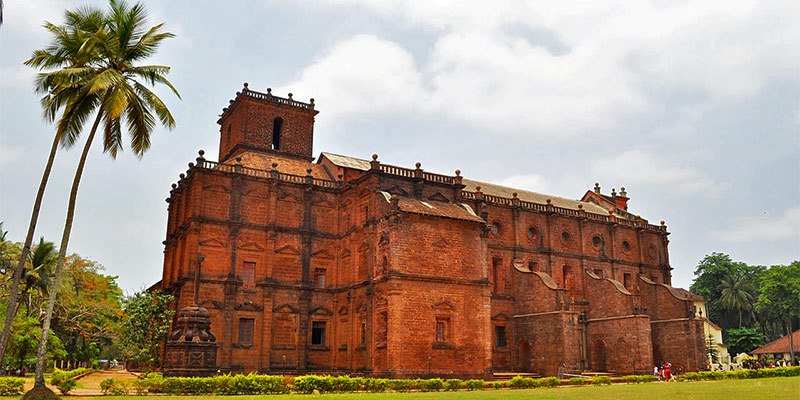
Built in the 16th century, this basilica is Goa’s most frequently visited tourist destination. Flaunting impressive Jesuit and Baroque architecture, this basilica was labelled as a World Heritage Monument.
The basilica also showcases some unique Corinthian and Doric works, sure to intrigue any Architecture or History enthusiast. With large, black, granite walls, basalt pillars and a sloping, tiled roof, the church uses some very diverse architectural techniques, while ensuring that the design remains relatively simple, yet sophisticated. There are tiny, ornate Latin and Portuguese inscriptions carved onto the gilded pillars, walls and altar of the church, reminding tourists that this basilica is a remnant from Goa’s rich, historical and cultural past. The body of St. Francis Xavier is also buried in one of the chapels here.
Although today, much of this church lies in ruins, the Basilica of Bom Jesus stands as an example of exemplary, flawless architecture.
Distance from Panjim: 13 km
Location: Old Goa Road, Bainguinim
2) Tomb of St. Francis Xavier
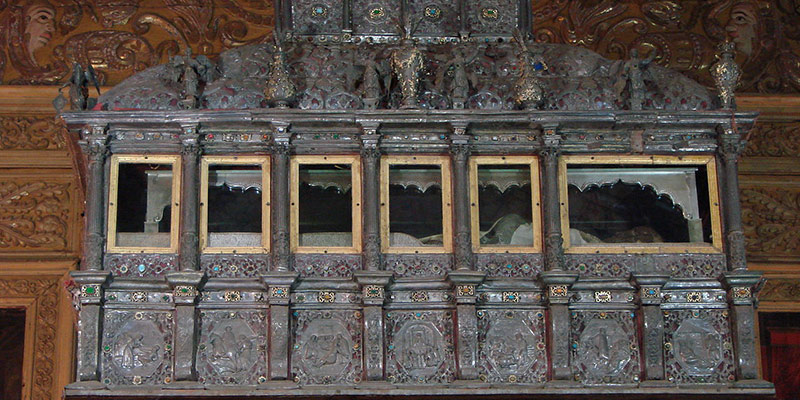
Within the Basilica of Bom Jesus, there lies the tomb of the revered Portuguese evangelist, St. Francis Xavier. During his stay in Goa, he has been said to have nursed the sick, opened up innumerable churches and even converted thousands of people to Christianity. He later travelled to the Far East where he continued his evangelical and missionary duties. Although he died on a tiny island in China, his body was brought back to Goa.
The tomb, which was only completed 140 years after St. Francis Xavier’s death, was carved by famed Italian sculptor, Giovanni Batista Foggini. Made of Jasper and marble, this tomb has three layers: the base, mausoleum and casket. The tomb is complete with delicate silver statues of the famous evangelist and ornate, bronze plates and large paintings, depicting scenes from St. Xavier’s life. The saint’s remains are unearthed and publicly displayed once every ten years.
Distance from Panjim: 13 km
Location: Within the Basilica of Bom Jesus, Old Goa Road, Bainguinim
3) Divar Island
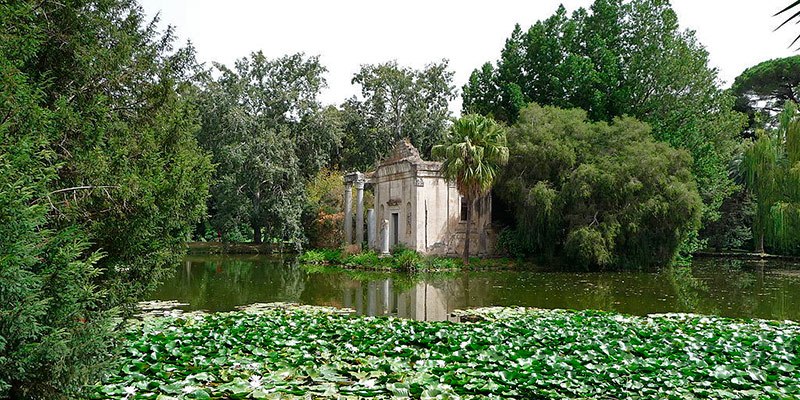
The Divar Island, located on the serene, crystal-clear Mandovi River, is not a very popular tourist destination, so is perfect for those looking to enjoy a day away from Goa’s hustle and bustle. Visitors must take a ferry from the Viceroy’s Arch in Old Goa and cross the deep, blue, paradisiacal waters of the Mandovi River to reach this quaint little island.
A short distance from the Divar Island wharf, there is the sacred Saptkoteshwar temple-one of the most revered Hindu worshipping sites in Goa. The picturesque Piedade village is a popular destination for those visiting this island. The ancient, 16th century “Our Lady of Compassion Church” rests delicately on top of a hill near this village.
Those visiting this island during August might be lucky enough to witness the rich, vibrant, Bonderam Festival, where cheerful men, women and children line the streets of the island, waving beautiful, colourful flags, celebrating the harvest season.
Location: Mandovi River
Distance from Panjim: 12 km
4) Reis Magos Fort: Panoramic Views of the Mandovi River
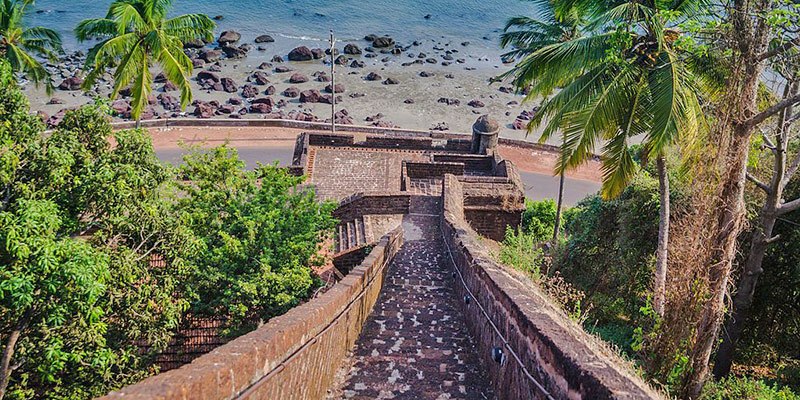
Source: wikimedia.org/wiki/File:Reis_Magos_Fort_(17310979208).jpg
Built in 1707, this edifice, overlooking the Badez Taluk, was the Portuguese’s first line of defence. Situated on the mouth of the Mandovi River, the Reis Magos Fort is one of Goa’s oldest citadels. Its strategic location and high, impregnable walls rendered it invaluable to the Portuguese colonists.
Although the fortress has undergone many renovations in recent years, it still remains a timeless beauty with its bright, reddish laterite stone walls and tall minarets, characteristic of Portuguese fort architecture. Complete with still intact underground tunnels and chambers, this fort is one of Goa’s best preserved historical sites. A trip to the Reis Magos Fort is not complete without a visit to the nearby Reis Magos Church which is another tourist hotspot.
This fort is only open to the public for a couple of hours every day, so knowing the fort timings beforehand will reduce unnecessary hassle during the excursion.
Location: Verem, Bardez
Distance from Panjim: 9 Kms
Also Read: Best Tours & Excursions in and Around Goa
5) Se Cathedral: A Magnificent Example of Portuguese Architecture
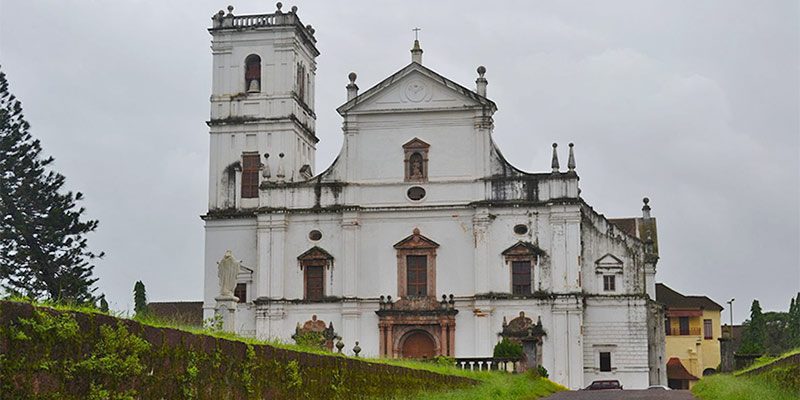
Flaunting Iberian architecture, this 16th-century edifice is the largest church in Asia and it is still operational! With high ceilings, intricate mosaic work and wooden carvings, this church is perhaps one of Old Goa’s most richly decorated buildings.
Dedicated to St. Catherine, this cathedral was built to commemorate the victory of Afonso Albuquerque and belongs to the Archbishop of Goa, today. Apart from the gilded altars, and rich paintings adorning the walls of the cathedral, there are also innumerable chapels and statues inside the church. Se Cathedral is laid out in the standard cruciform shape and above the altar there are gilded panels depicting scenes from St. Catherine’s life.
Like most tourist spots, this cathedral is open to the public only for a couple of hours each day, so visitors must make sure they know the relevant church timings so as to make the most of their visit here.
Location: Velha
Distance from Panjim: 13 Kms
6) Fontainhas: The Latin Quarter of Panaji
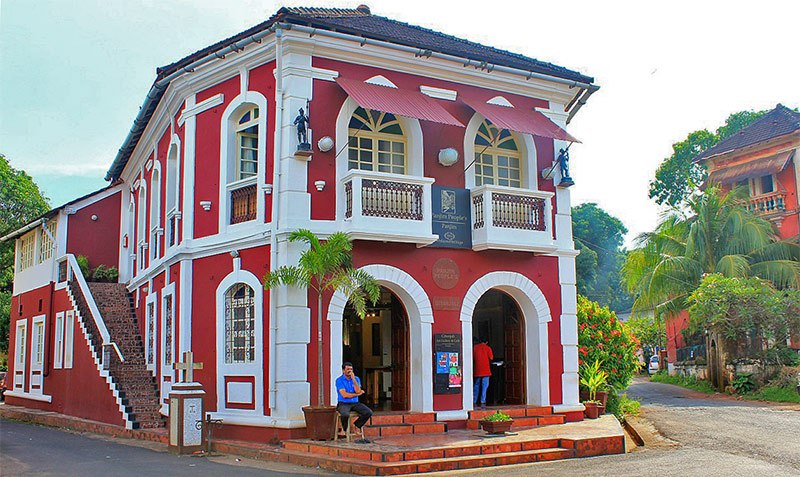
Source: commons.wikimedia.org/wiki/File:Gallery_de_Fontainhas.jpg
The Heritage Walk through Fonatainhas, a small Latin Quarter in Pajim, is a must for anyone looking to explore Goa beyond its beaches. A small spring –the “Fountain of Phoenix,”- gives the place its name.
Colourful houses line the winding streets. These houses seem to have come straight out of a kid’s colouring book- such is their cute, vibrant facade and simple architecture. The smell of freshly baked bread sifts out of bakery shop windows. There is a bright, red wishing well, too, where visitors can take respite before continuing their way up to Altinho Hill- a magnificent structure, home of the Chief Minister and Archbishop of Goa. En route, visitors can catch a short glimpse into the 19th century Chapel of St. Sebastian.
A walk through Fontainhas will not only prove enchanting and refreshing, but it is a great way to learn more about Goa’s rich cultural past.
Location: Panjim
Distance from Panjim: 1 km
7) Wax World Museum
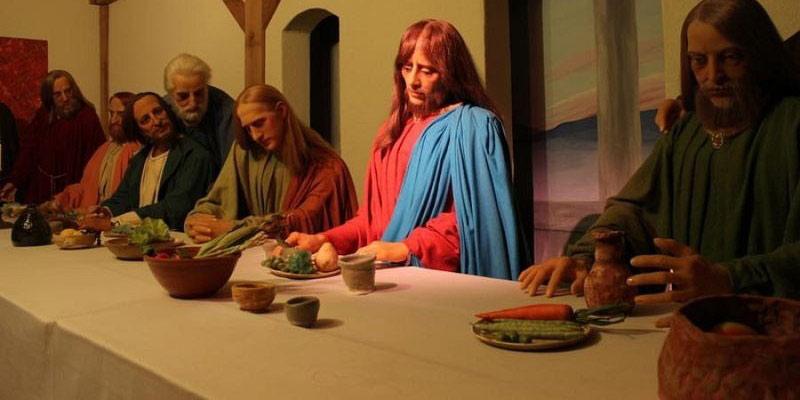
One of India’s few, large wax museums, this place has an extensive collection of 30 life-size paraffin sculptures. The statues include famous Indian personalities, including Mahatma Gandhi and Mother Teresa. However, the museum’s most famous attraction is the sculpting of Jesus Christ’s “Last Supper,”- a truly wondrous piece of artwork, sure to leave visitors captivated! A guided tour is available in English and Hindi, for those visitors who wish to learn more about each sculptor.
There is a small entry fee which should not be too much of a hindrance to visitors, but photography is strictly prohibited unless visitors make a camera pass beforehand at the museum’s counter. There is a small gift shop selling a range of merchandises, too, so tourists can pick up a small souvenir here, with which to remember their visit to the World Wax Museum.
Location: Ella
Distance from Panjim: 12.5 km
Also See: 10 Things You Must Do in North Goa
8) Ruins of St. Augustine Church: Echoes of a Bygone Era
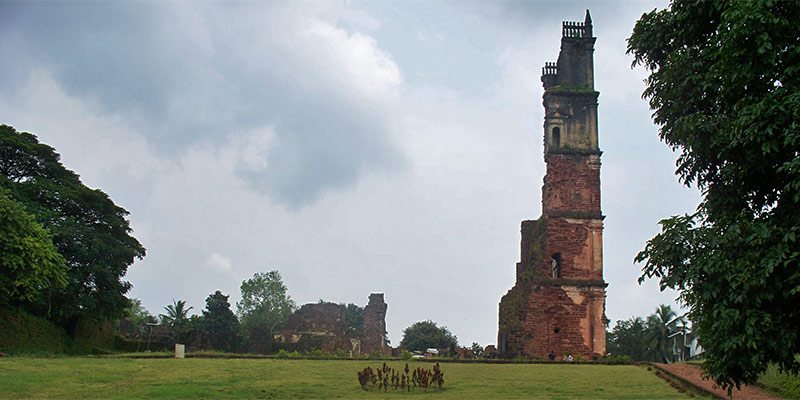
Source: wikipedia.org/wiki/File:The_Tower_of_The_Church_of_St._Augustine.jpg
The St. Augustine Tower, formerly a 46m high belfry, is one of the most spectacular historical sites in Old Goa and is associated with the famed Nossa Senhora de Graca Chuch, built by the Augustinian Friars sometime in the early 17th century. This church rests on top of the Monte Santo Hill in Velha, the primary site for the Augustinian Order.
The St. Augustine Church included eight, richly decorated chapels, innumerable altars, and a few chambers all designed by presumably, an Italian architect. The Church was said to be one of the three most renowned examples of Iberian architecture in the world, so this destination is sure to be a treat for anyone with a keen interest in that area.
Decades of neglect and bad maintenance rendered the fort unusable and by 1938, much of the building had collapsed, leaving only the high belfry tower standing.
Location: Velha Goa
Distance from Panjim: 12 km
9) Church of St. Cajetan: Gothic Splendor in Old Goa
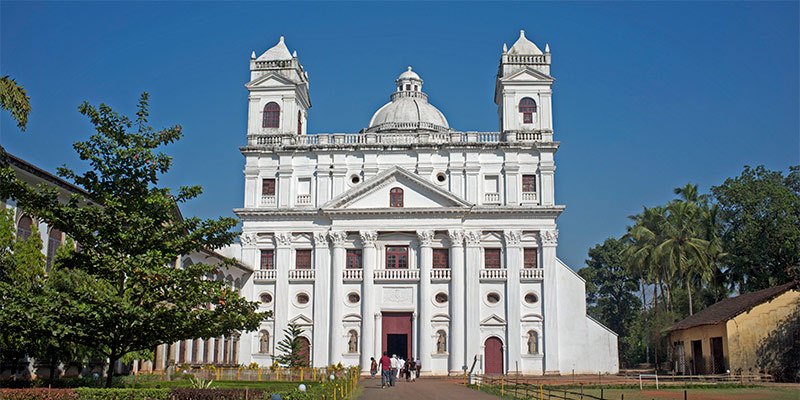
Source: flickr.com/photos/84292292@N00/6849994477
Dedicated to St. Cajetun, a contemporary of St. Francis Xavier, this church is Goa’s most beautiful and best preserved historical site. Displaying gorgeous Corinthian style architecture, this church is reminiscent of the St. Peter’s Basilica in Rome. The walls of the church are adorned with vibrant paintings depicting the life of St. Cajetun. Ornate statues are built into little niches within the church walls and the altars flaunt delicate carvings.
Elaborate gateways, with tiny Hindu inscriptions decorate the archways of this church. Built by Italian monks of The Theatines in 1665, the church contains a small, 22 meter deep well, and a small convent which used to house visiting governors or other notable dignitaries.
The Church of St. Cajetun has withstood the tests of time. Combining beauty and elegance, the St. Cajetun Church is a must visit for any tourist looking to delve deep into Goa’s rich and glorious past.
Location: Velha
Distance from Panjim: 12 km
10) Archaeological Museum and Portrait Gallery: Treasures of Old Goa

Established in 1964, the Archaeological Museum contains artefacts from the pre-historic, early historic and late medieval periods. The museum houses innumerable portraits, wooden sculptures, large, ornate pillars, delicate postal stamp collections and other objects from the Portuguese period. Although the place is filled with many awe-inspiring relics from the past, the more famous attractions in this museum include the John the Baptist, wooden statue, the Ivory sculpture showing Christ’s crucification and a bronze statue of Goa’s first governor, Albuquerque.
Apart from these captivating, historic relics, there is also a children’s activity centre and a small video screening session showing the different World Heritage Properties in India.
Visitors must make sure they know the relevant museum timings, beforehand. A look through this museum is definitely worth the five rupee entree fee and the age-old inscriptions, arms and plates will surely let visitors experience Goa’s rich cultural and historical past, first hand.
Location: Beside the Church of St. Francis of Assissi
Distance from Panjim: 11 km
Bonus Places:
11) Mangueshi Temple: Spiritual Oasis amidst Christian Heritage
Amidst the Christian heritage of Old Goa, the Mangueshi Temple stands as a testament to Goa’s religious diversity. Dedicated to Lord Shiva, this ancient temple is known for its intricate architecture, vibrant festivals, and sacred rituals that draw devotees and tourists alike.
12) Church of St. Francis of Assisi: A Testament to Franciscan Heritage
Immerse yourself in the serene ambiance of the Church of St. Francis of Assisi, a symbol of Goa’s Franciscan heritage. Admire the intricate carvings, ornate arches, and the exquisite paintings adorning its interiors, including the renowned ‘Tree of Jesse’ fresco depicting the genealogy of Christ. Explore the adjacent Archaeological Museum to uncover artifacts and relics dating back to the Portuguese era.
13) Viceroy’s Arch: Gateway to Old Goa
Stand in awe before the Viceroy’s Arch, a historic monument that once welcomed dignitaries and colonial rulers to the illustrious city of Old Goa. Built in the 16th century by the Portuguese viceroy, Francisco da Gama, the arch served as a ceremonial gateway to the city and bears witness to centuries of history and conquest. Admire the intricate carvings, imposing pillars, and the regal coat of arms that adorn its façade.
14) Chapel of St. Catherine
Tucked away amidst lush greenery, the Chapel of St. Catherine is a serene oasis of tranquility in Old Goa. Built in the 16th century, it offers a peaceful retreat for contemplation and prayer amidst scenic surroundings.
15) Museum of Christian Art
Located within the Convent of Santa Monica, the Museum of Christian Art is dedicated to preserving and promoting the artistic legacy of Goa’s Christian community. It houses a remarkable collection of religious art, including altarpieces, sculptures, and ivory artefacts.
FAQs About Old Goa
What is the best time to visit Old Goa?
The best time to visit Old Goa is during the winter months from November to February when the weather is pleasant, and the festivities are in full swing.
How can I travel around Old Goa?
Old Goa is easily accessible by road, with taxis, buses, and rental bikes available for convenient travel within the town. Exploring on foot is also a great way to soak in the charm of its cobblestone streets.
Are there any accommodation options in Old Goa?
Yes, Old Goa offers a range of accommodation options, including heritage hotels, boutique guesthouses, and budget-friendly hostels, catering to diverse preferences and budgets.
What are some must-try dishes in Old Goa?
Indulge in the flavors of Goan cuisine with dishes like Vindaloo, Sorpotel, and Bebinca, tantalizing your taste buds with a burst of spices and aromas unique to the region.
Is Old Goa suitable for solo travelers?
Absolutely! Old Goa welcomes solo travelers with open arms, offering a safe and enriching experience amidst its vibrant streets and warm hospitality.
Are there any safety precautions I should take while visiting Old Goa?
While Old Goa is generally safe for tourists, it’s advisable to exercise caution, especially while exploring secluded areas or traveling alone at night. Keep your belongings secure and stay informed about local customs and regulations to ensure a hassle-free experience.
Old Goa stands as a timeless testament to India’s rich cultural heritage, beckoning travelers with its architectural splendors, cultural vibrancy, and scenic beauty. Whether you’re a history enthusiast, a nature lover, or a seeker of spiritual solace, this quaint town promises an enriching experience that lingers in the heart long after the journey ends.
Also Read: 15 Less Known Beaches in Goa
Last Updated on April 1, 2024 by Rohan

